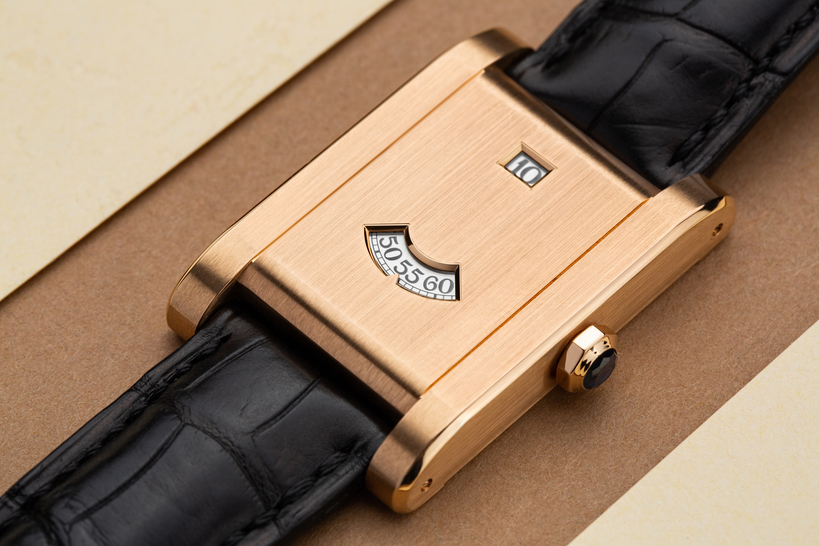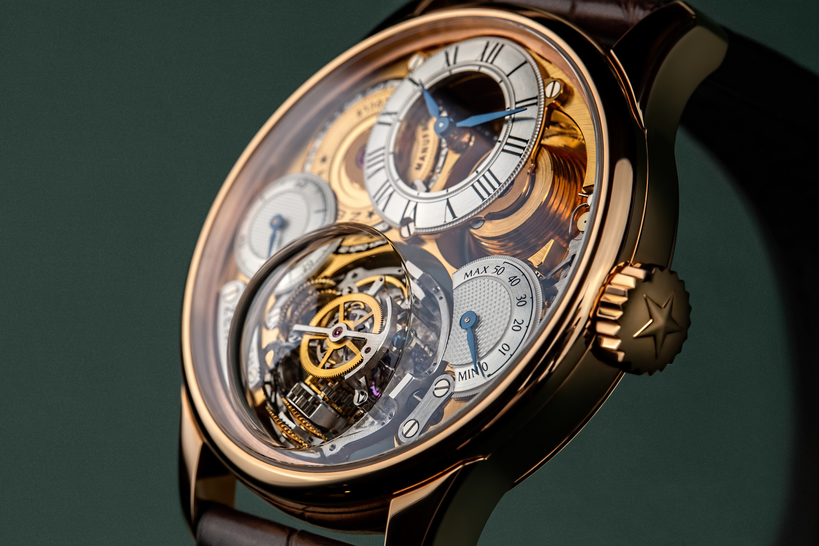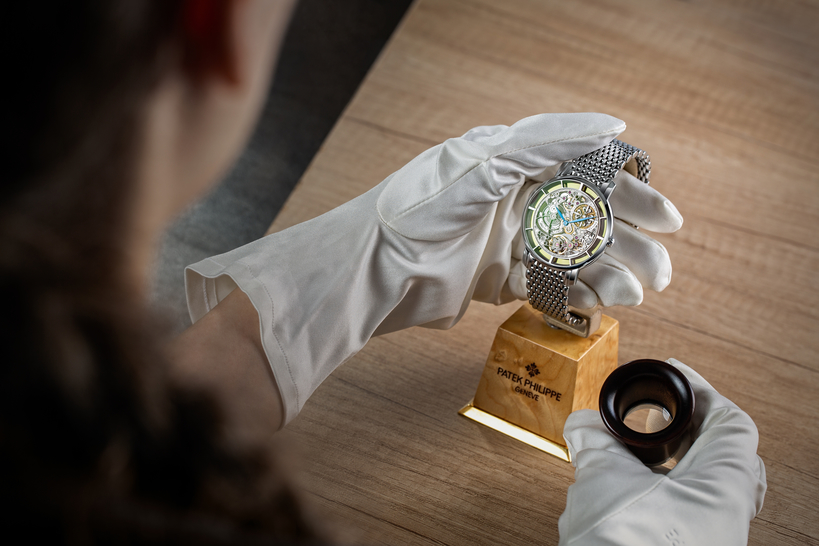The results of the November sales held by the big three auction houses in Geneva didn't go by without setting new records.
Phillips auction house had the most diverse program at their new auction venue in the Hotel President Geneva on November 8 - 10. Their auctions were staged over two sessions called Reloaded: the Rebirth of Mechanical Watchmaking, 1980-1999, and the Geneva Watch Auction: XX.
Reloaded got underway and immediately set a world record without any warm-up. It was set by the unique F.P. Journe Tourbillon à Remontoire d'Egalité prototype from 1993, otherwise known simply as the Tourbillon 15/93 by fans of Journe's creations. This was only the second wristwatch ever fully made by François-Paul Journe, who subsequently decided to found his own company and begin launching his own watches.
The experts call this a historic watch, as it had a visible influence on the appearance of Journe's modern complicated wristwatches. So this piece sold for CHF 7,320,000! Not only is this a record for Journe's himself, it's now also the most expensive watch in the world by an independent watchmaker.
The watch was accompanied by original technical drawings with hand-written calculations made by the great watchmaker, and even the metal sheet that Journe cut the tourbillon cage out of! Second place was predictably occupied by the first Rolex Daytona "Rainbow" Ref. 16599SAAEC.
Rolex Daytona collectors are fully aware of the diverse variety of bezels this chronograph comes equipped with, especially on privately commissioned models — it's the reason why many of them collect these watches. For a long time, the watch community believed that the first Daytona "Rainbow" appeared when it debuted as a regular production model in 2012.
However, it came to light that one lucky person convinced Rolex to make a watch for them way back in 1994 with a bezel encrusted with baguette-cut sapphires, where dark-red stones gradually transition to orange, yellow, green, blue, and deep purple.
The model was referenced 16599SAAEC, where SAAEC is an acronym for "Sapphire Arc-en-Ciel", which can be translated from French as "Sapphire Rainbow". This model was actually the first-ever Daytona "Rainbow". Back then, Rolex chronographs were still equipped with cal. 4030 based on Zenith's El Primero movements.
In short, this was the first time that the Rainbow Zenith Daytona resurfaced at an auction, and it instantly became the most expensive automatic Rolex Daytona, raising CHF 5,505,000. Third place was unsurprisingly occupied by a model made in 2005 called the Derek Pratt for Urban Jürgensen Detent Escapement Tourbillon with Remontoire in an oval case, or just the Derek Pratt Oval for short.
It's a unique pocket watch with a détente escapement, tourbillon, power reserve indication, moon-phase display, and thermometer in a platinum case that measures 76 mm × 62 mm. The greatest unknown British watchmaker Derek Pratt made everything in this watch with his own hands, and he invented his own form of détente escapement.
The watch was acquired for CHF 3,690,000, making a very impressive debut! Fourth place was occupied by a platinum Philippe Dufour Duality with the signature double escapement behind the name "Duality". One of the ten known models was acquired here for CHF 1,512,000, almost reaching its pre-sale upper estimate.
And another watch that surpassed the million mark when it sold for CHF 1,117,600 was Patek Philippe's minute-repeating perpetual calendar Ref. 3974 with a moon-phase display and 24-hour indication, made in 1989. The watch was launched to mark the grand maison's 150th anniversary.
Ref. 3974 was the first minute-repeating wristwatch with an automatic movement. The watch in a white-gold case measuring 36 mm in diameter isn't the rarest, but it's highly sought-after on the pre-owned market, as you can tell by its final sales price. We should also mention the success of a model from 1998 by A. Lange & Söhne: the Tourbillon "Pour le Mérite" Ref. 701.007 with a blue dial in white gold.
For the 102nd piece in the series of 150, i.e. a watch that isn't rare at all, it raised a very decent sum of money: CHF 469,900. That's at least if you compare this to the result achieved by the exact same "Pour Le Mérite" in platinum sold over the same days by Sotheby's.
Energy Supplement
Despite the fact that Phillip's 20th November sale in Geneva was billed as a supplement to the Rebirth of Mechanical Watchmaking, it was no less interesting. As predicted, the star lot at the Geneva Watch Auction: XX turned out to be the Rolex Cosmograph Daytona "Paul Newman Lemon" Ref. 6264.
There was an intense bidding battle for this chronograph with an extraordinarily rare combination of a yellow-gold "Paul Newman Lemon" dial paired with counters and an outer track in deep "tropical" brown, and the final sales price for the watch from 1970 was one and a half times its upper estimate (CHF 800,000 - 1,600,000). It realized a final sales price of CHF 2,480,000.
Second place was secured by a tourbillon made by a young independent watchmaker still in his thirties with Albanian roots — Rexhep Rexhepi. This guy began his watchmaking career at fourteen years of age! He started out at Patek Philippe, then worked for François-Paul Journe and BNB, before opening his own workshop, Akrivia. Rexhep Rexhepi's first wristwatch was a tourbillon like Journe's.
And Rexhepi's was no simple tourbillon, it was accompanied by a monopusher chronograph and a powerful mainspring barrel. He developed and made all of these modules himself, before housing them in a 43-mm titanium case. And now collectors from all over the world are vying for this watch. The watchmaker's first independent opus sold for CHF 1,079,500.
His chronometers fetch bigger sums these days, but you have to agree that this is still a huge success. Rexhepi's success looks all the more impressive given that his mentor F.P. Journe's milestone Tourbillon Souverain watch from 2001 sold for a lower price of CHF 1,041,400, securing third place. And this was one of six known examples in platinum cases measuring 38 mm in diameter with pink-gold dials.
Overall, this is a very significant watch from a historical point of view — awarded the top Aiguille d'Or prize at the Grand Prix d’Horlogerie de Genève (GPHG). There were no more watches then passed the million mark at Phillip's 20th fall auction in Geneva.
However, presumably the same one lucky bidder deserves to be commended for managing to nab a pair of Holy Grail watches for the same price of CHF 876,300: Patek Philippe's Ref. 1518 (from 1951 in a pink-gold case) and Ref. 2499 (from 1980 in a yellow-gold case).
We can mention another big achievement for the Saxon manufacture A. Lange & Söhne, whose unique model celebrating the 25th anniversary of their first chronograph, the Datograph Up/Down "Hampton Court Edition", quadrupled its upper estimate when it sold for CHF 825,500.
Sotheby’s Eternal Treasures
Organizers of the self-explanatory auction, Treasures of Time, placed their bets on all-time worldwide bestsellers: Patek Philippe's Ref. 2499 and Ref. 1518 perpetual calendars. But to everyone's surprise, the top lot at this sale turned out to be an extremely rare split-seconds chronograph: Patek Philippe's Ref. 1563.
When the watch appeared in the post-war years with a price tag of CHF 2,000, it was seen as too expensive — there was practically no demand for it, and it was soon discontinued. That's why there are only three known examples today. One of them once belonged to the great jazz pianist and composer Duke Ellington and now resides in the Patek Philippe Museum.
Ultimately, this unique model with Breguet numerals and added lume set in hard enamel was acquired for CHF 3.36 million. And when this watch made its first reappearance on the pre-owned watch market eleven years ago at Christie's auction, it sold for CHF 1,445,000. What a terrific investment!
Three other models surpassed the million mark at Sotheby’s sale. As everyone expected, they were the two Ref. 2499 watches and the Ref. 1518. In the end, the watch that came second with a final sales price of CHF 3.12 million was the pink-gold Ref. 2499 in a Wenger case.
What makes this model unique is that it arrived in a case made in 1950, although everyone knows that the reference 2499 was only officially introduced a year later when it went on sale in 1951. Collectors have dubbed this reference number the Mona Lisa of haute horlogerie. According to the manufacture's archives, there should be three of these Mona Lisas in Wenger cases.
But the present example is the only one to have ever resurfaced at an auction. The other two remain in private collections. The rarity of this example is underscored by the fact that there isn't even a "First Series" pink-gold Ref. 2499 in the Patek Philippe Museum in Geneva. The Swiss franc carried more weight twelve years ago.
That's why the organizers have given the present lot a pre-sale estimate within the range of CHF 2,500,000 - 5,000,000. The watch ultimately went for CHF 3.12 million. The last time this model in case no. 687'772 appeared at an auction, it was sold by Christie's in May 2012 for CHF 2,547,000.
The second "Third Series" Ref. 2499 from 1954 has a case numbered 2’632’514 and houses movement no. 868’764. The secret to this piece's success lies in its unique dial coated in black lacquer with applied Breguet numerals. It sold for CHF 2.28 million here. Compare that to 2010, when it was also sold in Geneva by Christie's for a quarter of the price: CHF 579,000.
And finally, we have the founding father of this family of watches and first serially produced perpetual calendar chronograph wristwatch: Patek Philippe's Ref. 1518. The present example in pink gold was made in 1948, shortly before the reference was replaced by the new Ref. 2499 in 1950. This lot sold for CHF 1.56 million.
We should point out that the top-ten most expensive watches include three models by A. Lange & Söhne. The two Tourbillon "Pour Le Mérite" models sold for CHF 300,000 (platinum) and CHF 264,000 (pink-gold), while the more complicated platinum Tourbograph "Pour Le Mérite" only raised CHF 228,000. Sotheby's held their Important Watches sale alongside Treasures of Time.
It didn't make great achievements, but Patek Philippe's same Ref. 2499 perpetual calendar chronometer from 1954 in a yellow-gold case sold very successfully, and its consignor should be particularly pleased. They acquired the watch at Phillips auction for CHF 1,482,000 three years ago, at a time when the pre-owned watch market was unusually primed. And now the model has gone for CHF 2.4 million.
Christie's Fails Again
The British auction house hasn't been able to shake off its losing streak in Geneva since last year's failure. This year, Christie's initially wanted to limit events in Geneva to a mini charity auction called Rare Watches Including Watches for ELA (European Leukodystrophy Association) with a dozen lots.
Then at the last minute, they decided not to lose face, and convinced the American collector Gordon Bethune to consign part of his collection. But they probably shouldn't have — both Christie's and Mr. Bethune. To put it lightly, the sales weren't a success. Last year's instability was still fresh in the minds of collectors.
The heady hullabaloo with last-minute revisions to catalogs and starting prices for certain watches led one consignor who'd entrusted Christie's with his collection to file and later withdraw a lawsuit. This pre-auction favorite at Rare Watches was a rare pink-gold Rolex Ref. 6062 "Stelline" triple calendar model owned by Mr. Bethune with eight five-point stars that mark its dial.
It was acquired for CHF 2,223,000 exactly one year ago at Christie's infamously scandalous Genevan Passion for Time auction. Here, it sold for CHF 1,376,000 — closer to its lower estimate. The consignor blew a million dollars (or perhaps euro) just like that.
François-Paul Journe's first serially produced watch, and the world's first tourbillon with a constant-force mechanism — the F.P. Journe Tourbillon à Remontoir d'Égalité Ref. T, No. 062/00T from 2000 in pink gold with a white-gold dial — found a new owner willing to pay CHF 730,800. This was higher than its estimate (CHF 400,000 - 600,000), although the piece's value was clearly underestimated.
The exclusive, extremely rare and complicated Tourbillon Souverain Vertical "Black Label" (no. 122-TV) made in 2022 only raised CHF 378,000. This makes you wonder why Journe's rare watches can sell for 7.5 million at one auction but can't generate half a million at another. The biggest surprise at Christie's Rare Watches was a negative rather than a positive result.
First place was occupied by a perpetual calendar in a white-gold tonneau-shaped case: Breguet's No. 3218 Quantieme Perpetuel made in 1935, which achieved CHF 1,920,500. And it had been given an estimate of CHF 100,000 – 200,000. You can talk this watch up until you're blue in the face: it's rare, one of the only four known examples with a retrograde date, and it once belonged to the famous designer Paul Iribe.
Well, over the last few years, sales prices for the rarest models by Breguet rarely exceed CHF 100,000, and Paul Iribe is probably most famous for being Coco Chanel's lover for a period of time. This lot clearly doesn't spell a sudden surge in interest in Breguet among collectors.
It's more than likely that Swatch Group CEO Nick Hayek Jr. stepped in himself, who isn't indifferent to the falling prices for this watch brand's flagship models at the auctions. You only need to recall the results of Monaco Legend Group's October Exclusive Timepieces auction, where a collector's set of a platinum Breguet Souscription Ref. 3430 pocket watch and Ref. 1819 wristwatch from 1991 only raised a mere EUR 123,500.
And while the purchase at Christie's may have looked a bit too conspicuous, even this level of interest is still better than indifference. Breguet's owners should seize the moment: it looks like prices for watches by the world's greatest watchmaker of all time are set to increase soon.
Credits provided by: www.phillips.com, www.sothebys.com, www.christies.com


























